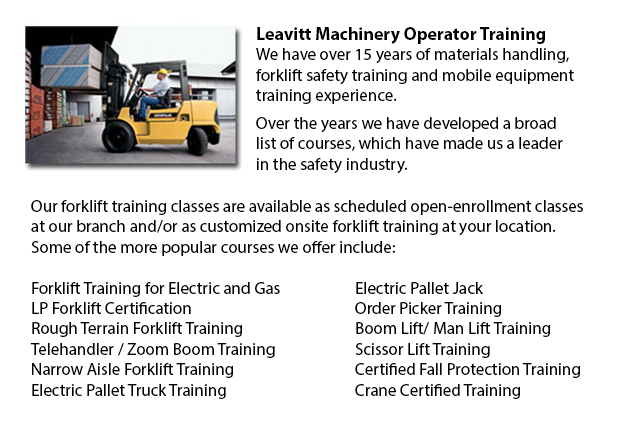
Rough Terrain Forklifts Training Windsor - There are in actual fact two distinctive classifications of forklifts within the materials handling market, the industrial model and the rough terrain model. Rough terrain forklifts first arrived on the marketplace in the 1940's and were being primarily utilized on coarse roads, best for areas where no covered surfaces were available, like construction sites and lumberyards.
Rough terrain forklifts usually utilize an internal combustion engine with a battery for power. The engines are able to function on propane, diesel or gas. Several manufacturers are playing with rough terrain forklifts that make use of vegetable matter and run from ethanol. Large pneumatic tires with deep treads characterize these vehicles to allow them to clutch onto the roughest ground type without any misstep or drifting.
The most primitive designs of all terrain forklifts were able to carry weights of up to 1000 lbs, using forks that could slide beneath the item, lift it a tiny bit and then transfer it to an alternate location. After a decade on the market, all terrain vehicles had been given additional hauling power to about 2000 lbs capacity. In the 1960's telescoping booms were added, permitting them to stack supplies a good deal higher than in preceding years. The telescoping design feature is a staple of most rough terrain forklifts nowadays. Present styles are capable of handling well over 4000 lbs due to the continued improvements over the years. Telescoping ability has also improved with some models attaining a height of 35 feet. Worker safety has also become a focus with many all terrain lift trucks currently built are fitted with an enclosed cab for the driver, versus the older open air seating capacity.
The all terrain forklifts available today work equally as well on covered floors as on unpaved surfaces. These all terrain lift trucks are being marketed for their versatility enabling firms to transfer parts from outside the plant to the inside or vice versa.
-
Reach Trucks
Reach Truck Training Windsor - Reach Trucks are mechanized equipment used for loading and storage in some companies that maintain storage of materials to finished goods on a pallet which are then inserted into lofty shelving units. This loading appli... More -
Hyster Forklift
Hyster Forklift Training Windsor - Hyster is a global company that builds in excess of 300 distinct types of lift trucks. However, it began as a producer of lifting machinery as well as winches. Most of its production was concentrated in the northw... More -
Scissor Lifts
Scissor Lift Training Windsor - The scissor lift, often acknowledged as a table lift, is an industrial lift that has been customized for use in wholesale and retail settings. Mechanized lifts have been used for decades in the manufacturing and produc... More -
JLG Telehandler
JLG Telehandler Training Windsor - In the late 1960's John L. Grove, with his wife Cora set out on a cross country voyage in their RV. Newly retired, after spending several years working with his brother to assemble their crane business into an marke... More -
Toyota Forklift
Toyota Forklift Training Windsor - Since 1992, Toyota Material Handling inc., U.S.A., also referred to as TMHU, has been the top selling lift truck dealer in the United States. This business has been situated out of Irvine, California for well over 4... More

Forklift Training Windsor
TOLL FREE: 1-888-254-6157
Windsor, Ontario
forklifttrainingwindsor.com
Email Us
About Us


